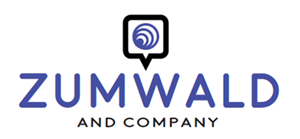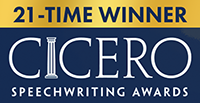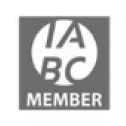10 tips for collaborating with a thought partner to write powerful speeches
Are you writing a speech with a crucial message and feeling the need to bounce your ideas off of a trusted colleague?
 Effective collaboration is the difference between a futile partnership and a phenomenal one.
Effective collaboration is the difference between a futile partnership and a phenomenal one.
Here are 10 tips for leaders who want to collaborate with a thought partner to write more powerful speeches.
Recently I had the honor of collaborating with a longtime executive on a speech she will deliver soon to an audience of about 3,000 people.
Her purpose was clear: to take a risk and share an important message on a provocative, sensitive, hot-button topic.
In general, this executive knew what she wanted to say.
But how best to frame it?
And then, how to say it?
That’s where she was struggling.
So she sought out a thought partner: a speechwriter willing to ask hard questions and challenge her thinking, her argument and her supports.
Ultimately, she wanted that crucial message in her speech to not only be perfectly clear but also profoundly inspirational – and land with her audience in just the right way.
She’d made some rough notes she was ready to share and eager to debate with me.
So we worked together with intention (and intensity) for about four weeks until we confirmed – for sure! – that This Was It.
This was The Final Speech.
In the end, she said, this collaboration was “a phenomenal process” that transformed her disparate thoughts into a solid speech with a confident message that she just can’t wait to deliver.
If you want to collaborate with a thought partner to write more powerful speeches, here are 10 tips that will help you.
 In the beginning
In the beginning
1 – Be willing to open up, be vulnerable and share.
A good thought partner – a good speechwriter – will take the time upfront to ask good questions about you, your life and your career journey to get to know you and what’s important to you.
This gives you the chance to share personal stories about what you believe and why, and what experiences have shaped you along the way.
A good thought partner will use “the best of the best” of these discoveries to make good decisions along the way about which examples, quotes, stories, beliefs, key words and phrases might be used in your powerful speeches.
(I was fortunate; I got to collaborate with an executive I connected with upfront – turns out we had a lot in common! – so she was more than willing to be open and honest about herself and her experiences.)
2 – Trust your thought partner to find the nugget to frame your speech.
During my first read-through of this executive’s rough notes about her speech, I noticed one idea that stood out from all the rest – one idea that could easily become the framework for her entire speech.
When I suggested it to her, she was more than surprised; to her, that idea was just a passing thought – an “oh, by the way.”
Once she saw that idea in a different light – as a framework instead – she embraced it and encouraged me to build it out.
 3 – Say what’s on your mind – or what’s floating around in your head – and then rely on your thought partner to sift and sort.
3 – Say what’s on your mind – or what’s floating around in your head – and then rely on your thought partner to sift and sort.
A good thought partner isn’t afraid to ask clarifying questions to learn what’s the most important thing.
In her rough notes, my executive had three big ideas she wanted to address.
But for a 10-minute speech, that was much too much.
So I asked her to weigh her ideas.
Which of those three ideas did she feel most strongly about?
The one that carried the most weight was the one we chose to pursue.
Her ability to weigh her ideas told me what to leave in – and what to take out.
It was a quick and easy way to sift and sort to keep the focus of her speech super sharp.
In the messy middle
4 – Sit for a while with the creative direction – then take the time to give feedback that’s thoughtful, detailed and specific.
During the research and interview process required for powerful speeches, your thought partner has collected (from your head) all the pieces of the potential puzzle that could find their way into your upcoming speech.
Now it is time for your thought partner to buckle down and make sense of it all.
The result is the creative direction – the outline that defines where the speech is going from beginning to end – so you can respond to something concrete.
Again, I was fortunate: The careful feedback my executive provided saved me both energy and hours.
Once she saw the roadmap of her speech on paper, in black and white, so many ambiguous points were suddenly clear, and she was able to decide with confidence:
“Yes, that’s exactly what I meant,” or “No, I don’t want to say that; I want to say this instead.”
 Her thoughtful feedback told me exactly where she felt comfortable (and where she felt uncomfortable).
Her thoughtful feedback told me exactly where she felt comfortable (and where she felt uncomfortable).
She was honest about what felt good to her – even great! – and what did not resonate.
Her feedback was clear:
- “Take out this point”
- “Add in this point”
- “Keep this short; important, but don’t need a lot of detail”
- “Balance this thought with that thought”
- “Use these words …”
- “Refine this point”
- “Here is a quote; see if this can fit”
- “I want to make it clear that …”
- “I want to include the word _____ somewhere, maybe around the concept of _____”
The clarity she provided resulted in an upfront direction that we both could feel good about before the drafting of the speech began.
By collaborating on the creative direction – the road map and vision for her speech – we went down the right path, together, from the beginning.
5 – Listen – carefully – to counterpoints, opinions and interpretations from your thought partner when vetting a sticking point.
 All of us can learn a lesson from this quote (often attributed to more than one person), which says:
All of us can learn a lesson from this quote (often attributed to more than one person), which says:
“I know you think you understand what you thought I said, but I’m not sure you realize that what you heard is not what I meant.”
That is why it is so important for you to listen carefully to your thought partner if he or she throws up a red flag – objecting insistently for some reason to a point you want to make or how you want to make it – as you’re creating powerful speeches.
Your first thought may be to dismiss or override an objection (after all, the point you want to make is clear to you). But resist that temptation.
Here’s a way ahead: If something isn’t sitting quite right with your thought partner, try explaining your point again – but in a different way.
Be honest. Be patient. And be persistent.
Stand your ground until you get your point across.
If you work to provide more clarity, there’s a good chance the lightbulb will soon go on; your thought partner will see your point and feed back to you precisely what is right (or wrong) about what you want to say and how you want to say it – and then suggest a fix.
If there’s been a misinterpretation, your thought partner will be able to point that out. And together you can reach a different solution that makes your point without any chance of confusion.
That’s what collaboration looks like when working with a thought partner to write powerful speeches.
6 – Be humble enough to make a change when your thought partner points out a blind spot.
A good thought partner is always looking out for you. Case in point:
 Somewhere along the way, my executive decided that she was no longer comfortable with a certain line in her speech.
Somewhere along the way, my executive decided that she was no longer comfortable with a certain line in her speech.
The words, she said, did not feel right. So she decided to take that line out.
Could one line make that much of a difference?
Yes, I told her, because she was removing a line that served as connective tissue from one critical story to her next important point.
Without it, I explained, “the audience would have no idea why you told that critical story in the first place.” Confusion would result.
It was a blind spot.
But once she understood why that line was in there – it served an important purpose! – we reworked that line until she felt comfortable. The rework kept the connective tissue in place and made the right transition to her next important point.
(True confession: Talking this out, together, made the new line even better than the old line!)
Once again, that’s what collaboration looks like when you’re working with a thought partner to write powerful speeches.
7 – Stop trying to shove a square peg into a round hole.
A couple of times, my executive wanted to include a metaphor that she knew would resonate with her audience because of how they’d been educated and trained.
And at first, I agreed.
 But in practice?
But in practice?
Those particular metaphors turned out to be much too complex because they would have required way too much time to set up and explain in her speech.
If your thought partner says she’s trying way too hard to make something fit, trust your partner.
And let it go.
8 – Go where the road leads you.
Don’t hold on tight to predisposed notions about how you think your speech should go.
If you do, you will likely miss some discoveries along the way.
Instead, follow the process.
Let your conversations with your thought partner show you the way.
Trust that answers will emerge the more you work together to write powerful speeches.
Here’s another confession:
That original nugget of an idea that I’d suggested in the beginning that we pursue as the framework for her speech? We kept pursuing it – until we decided (after a couple of drafts) that this precise angle might come off as a little disrespectful to a certain segment of her audience.
At first – it seemed like the entire premise of her speech was now down the drain!
But no:
We changed it by simply flipping the angle – just a little bit, just a handful of lines – in another direction. A better direction.
And made that same nugget work a whole lot better in the end.
 At the 11th hour (when it’s time to haul the speech away)
At the 11th hour (when it’s time to haul the speech away)
9 – Don’t be afraid to kill your darlings.
Sometimes a line or a phrase you were wedded to in the beginning just doesn’t fit in the end.
Or a piece of research such as famous quote that you believed was fascinating, clever – perfect! – no longer works.
Your thought partner may bring this to your attention because she can see what you may not be able to see.
Maybe your dearest darling is weighing down the cadence of your speech, making your key point weaker instead of stronger.
If so, be brave: Be willing to throw some things away.
Your speech will be the better for it.
10 – Beware of making rash changes at the bitter end (sleep on it first).
The night before my executive’s speech had to be finalized, I got an urgent text.
 “We need to fix this transition sentence. Can you call me?”
“We need to fix this transition sentence. Can you call me?”
So we talked it through. Fiddled with it. And put the matter to rest.
I woke up the next morning and knew something was wrong. I texted her a different line, which she said felt a lot better.
She was grateful. (After all, the stakes were high since this was a speech on a provocative, sensitive, hot-button topic; every word had to be exactly right.)
And finally we were done!
Or so I thought.
Later that afternoon, I got another urgent text.
“One more try on that transition sentence … how does this change look to you?”
Truth was – it didn’t work.
It was out of context.
The audience would hear that line – and immediately draw the wrong conclusion.
So we fiddled with it again. Talked it through. Sorted it out.
But this time, we discovered the real hang-up!
So we added the correct word (the only word that worked) and finally got that transition line exactly right.
Here’s the bottom line
What made this collaboration work was mutual respect.
 I had respect for her and her message.
I had respect for her and her message.
And she had respect for my ability to weave it all together into a structured, coherent, high-impact speech.
Remember: If you want to collaborate with a thought partner to write more powerful speeches, here are 10 tips that will help you:
IN THE BEGINNING
- Be willing to open up, be vulnerable and share.
- Trust your thought partner to find the nugget to frame your speech.
- Say what’s on your mind – or what’s floating around in your head – and then rely on your thought partner to sift and sort.
IN THE MESSY MIDDLE
- Sit for a while with the creative direction – then take the time to give feedback that’s thoughtful, detailed and specific.
- Listen – carefully – to counterpoints, opinions and interpretations from your thought partner when vetting a sticking point.
- Be humble enough to make a change when your thought partner points out a blind spot.
- Stop trying to shove a square peg into a round hole.
- Go where the road leads you.
AT THE 11TH HOUR (WHEN IT’S TIME TO HAUL THE SPEECH AWAY)
- Don’t be afraid to kill your darlings.
- Beware of making rash changes at the bitter end (sleep on it first).

















